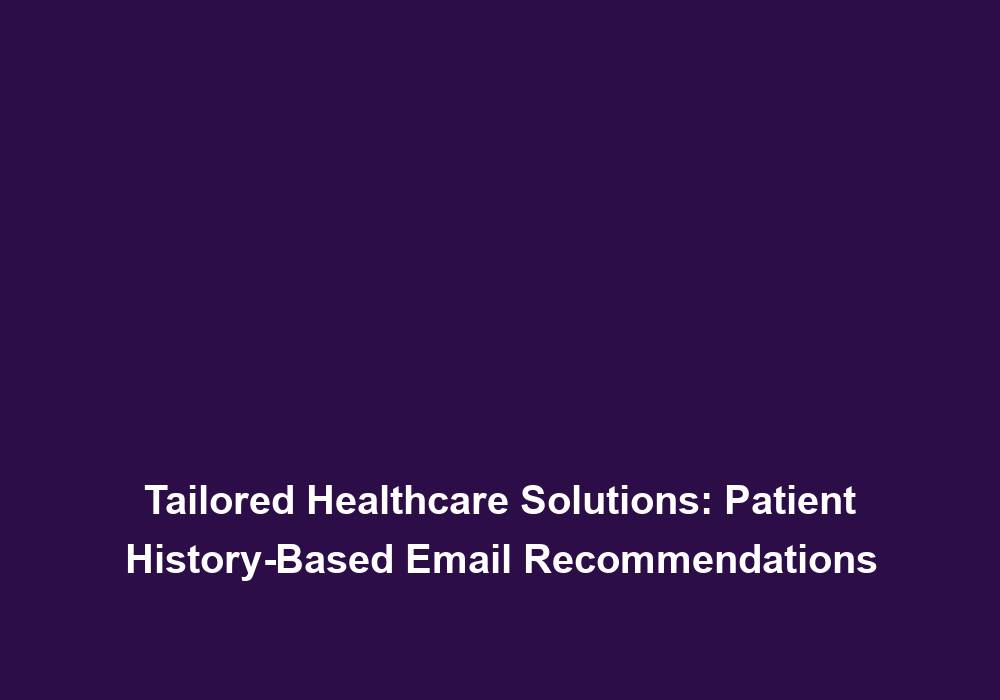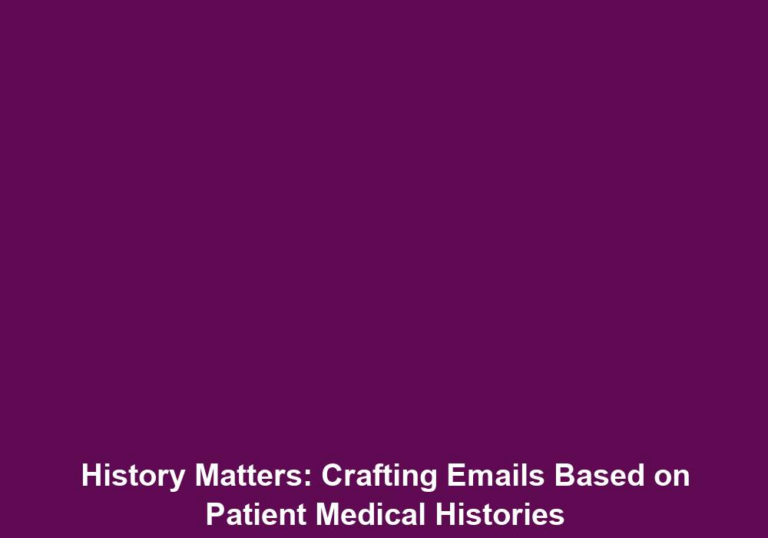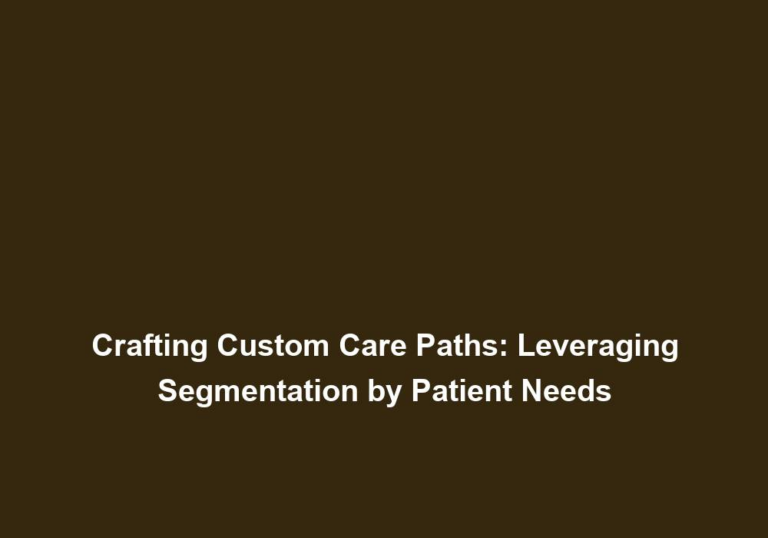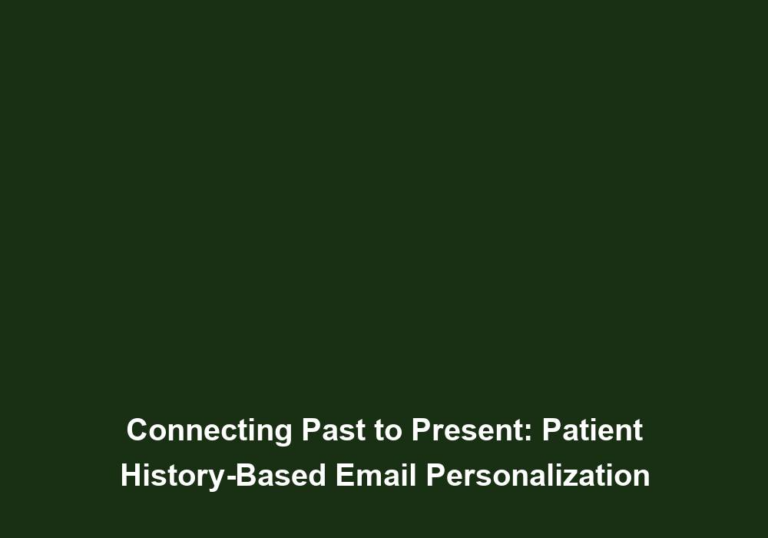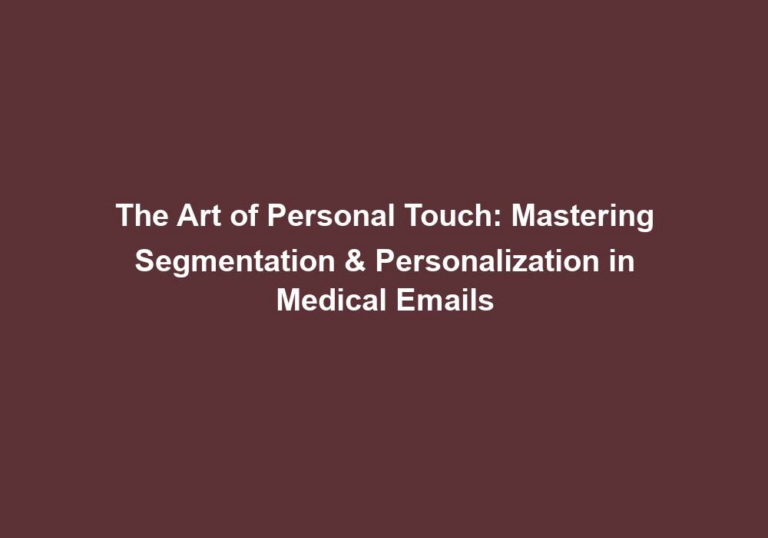Tailored Healthcare Solutions: Patient History-Based Email Recommendations
In the era of advanced technology and personalized healthcare, tailoring healthcare solutions to individual patients has become a crucial aspect of patient care. One effective way to provide personalized care is through patient history-based email recommendations. This innovative approach leverages patient data and analytics to offer tailored healthcare solutions directly to patients’ inboxes. In this article, we will explore the benefits and importance of patient history-based email recommendations in healthcare.
Understanding Patient History-Based Email Recommendations
Patient history-based email recommendations involve analyzing a patient’s medical history, preferences, and needs to provide them with personalized healthcare recommendations via email. By utilizing data analytics and artificial intelligence, healthcare providers can identify patterns and trends in a patient’s medical history, enabling them to offer targeted recommendations that address their unique requirements.
Patient history-based email recommendations offer a multitude of benefits in healthcare:
-
Improved Patient Engagement: Patient history-based email recommendations foster active patient engagement by providing them with relevant and personalized healthcare information. This approach empowers patients to take a more active role in their healthcare decisions and encourages them to adhere to treatment plans. By receiving tailored recommendations directly in their email inbox, patients can stay informed about their health and make informed decisions.
-
Efficient Communication: Email is a widely used and convenient communication channel. By utilizing patient history-based email recommendations, healthcare providers can efficiently deliver important healthcare information directly to patients. This method ensures that patients receive timely updates, reminders, and recommendations that are specific to their needs. It allows healthcare providers to reach a large number of patients simultaneously, saving time and resources.
-
Cost-Effective Solution: Patient history-based email recommendations offer an affordable and scalable solution for delivering personalized healthcare information. Compared to traditional methods of communication, such as phone calls or in-person visits, email recommendations reduce costs associated with administrative work and improve overall efficiency. Healthcare providers can focus their resources on delivering quality care instead of spending excessive time on manual communication.
-
Enhanced Patient Satisfaction: The delivery of personalized healthcare recommendations demonstrates a healthcare provider’s commitment to patient-centered care. By tailoring information to the unique needs of each patient, healthcare providers can significantly enhance patient satisfaction and strengthen the doctor-patient relationship. When patients feel that their healthcare provider understands their individual needs and preferences, they are more likely to trust and engage in their treatment plans.
-
Healthcare Education and Empowerment: Patient history-based email recommendations serve as a valuable educational tool, allowing healthcare providers to educate patients about their conditions, treatment options, and preventive measures. By promoting patient education and empowerment, this approach encourages patients to actively participate in their own healthcare journey. Patients can access information about their health at their convenience, enabling them to make informed decisions about their well-being.
Implementing Patient History-Based Email Recommendations
Implementing patient history-based email recommendations requires a systematic approach and the integration of technology solutions. Here are the key steps involved in deploying this innovative healthcare solution:
-
Data Collection and Analysis: To provide personalized recommendations, healthcare providers must collect and analyze patient data to gain insights into their medical history, preferences, and needs. This data can be collected through electronic health records (EHRs), patient surveys, or other sources. Advanced analytics tools can then be utilized to identify patterns and trends that can guide personalized recommendations.
-
Segmentation and Personalization: Once patient data has been analyzed, healthcare providers can segment patients into groups based on their shared characteristics and healthcare needs. This segmentation allows for the creation of personalized email recommendations that address specific patient requirements. By tailoring recommendations to each patient segment, healthcare providers can ensure that the information is relevant and meaningful.
-
Content Creation: Healthcare providers need to develop informative and engaging content for their email recommendations. This content should be tailored to the unique needs of each patient segment and cover topics such as treatment options, medication reminders, lifestyle changes, and preventive measures. By providing comprehensive and relevant information, healthcare providers can empower patients to make informed decisions about their health.
-
Email Automation: To efficiently deliver patient history-based email recommendations, healthcare providers can leverage email automation tools. These tools enable personalized emails to be sent automatically based on predefined triggers, such as appointment reminders, test results, or specific healthcare events. Automation ensures that patients receive timely and relevant recommendations without the need for manual intervention.
-
Continuous Evaluation and Improvement: Implementing patient history-based email recommendations is an iterative process. Healthcare providers should continuously evaluate the effectiveness of their email recommendations and make necessary adjustments based on patient feedback and analytics. This ongoing evaluation ensures that patients receive the most relevant and valuable information, improving the overall impact of the recommendations.
Challenges and Considerations
While patient history-based email recommendations offer numerous benefits, there are certain challenges and considerations to keep in mind:
-
Data Privacy and Security: Healthcare providers must ensure that patient data is handled securely and protected from unauthorized access. Compliance with data protection regulations, such as the Health Insurance Portability and Accountability Act (HIPAA), is essential. Implementing robust security measures and encryption techniques can safeguard patient information.
-
Opt-In and Opt-Out Mechanisms: Patients should have the option to opt-in or opt-out of receiving email recommendations. Healthcare providers must respect patients’ preferences and provide a convenient way to manage their communication preferences. This ensures that patients have control over the information they receive and allows them to tailor their communication with healthcare providers according to their needs.
-
Accurate Data Collection: To provide accurate recommendations, healthcare providers must ensure the quality and integrity of the patient data collected. Measures should be in place to verify the accuracy of data and correct any inconsistencies or errors. Regular data audits and validation processes can help maintain data accuracy and reliability.
-
Deliverability and Spam Filtering: Healthcare providers need to ensure that their email recommendations reach the intended recipients’ inboxes and do not get filtered out as spam. Implementing best practices, such as using reputable email service providers and monitoring deliverability rates, can help overcome this challenge. Healthcare providers can also encourage patients to add their email addresses to their safe senders list to avoid emails being marked as spam.
Conclusion
Patient history-based email recommendations offer a powerful solution for delivering personalized healthcare information directly to patients. By leveraging patient data and analytics, healthcare providers can enhance patient engagement, improve communication efficiency, and empower patients to actively participate in their healthcare journey. By following a systematic approach and addressing key considerations, healthcare providers can successfully implement patient history-based email recommendations and revolutionize the way they deliver personalized care.

